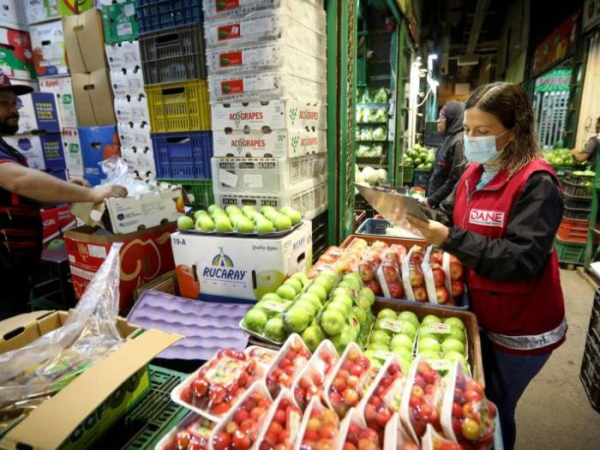The inflationary phenomenon is still present, and the official figures that the Dane gave on Saturday for January account for it. In the first month of the year, the consumer price index (CPI) registered a variation of 1.78%. This behavior led the annual figure to settle at 13.25%, the highest figure in 24 years, since March 1999, when it registered a figure of 13.51%.
(Annual variation of inflation was 13.25% in January).
The monthly data was slightly higher than that of January 2022 (1.67%), while the annual variation practically doubled the data from a year ago, which was 6.94%. Despite the increase with which the year began, the figure was within the range of expectations held by the market.
The director of Dane, Piedad Urdinola, explained that, while last year’s trend had been marked by the category of food and non-alcoholic beverages, In January, the greatest weight in the basket was given by the transportation side, an item that contributed 0.51 percentage points to the 1.78% variation, and which saw an increase of 3.58% in relation to December prices. of 2022.
“The protagonist in the month was transportation, and it is basically explained by the increases in municipal transportation and all regulated transportation, whose rates are felt by all Colombians,” indicated the official.
(Relive the Dane’s January 2023 inflation press conference.)
However, food was located, not far behind, as the second category that boosted inflation in the first month of the year, with a contribution of 0.49 percentage points, and an increase of 2.46%. The increase in the restaurants and hotels category was also highlighted, which increased 3.11% and registered increases in food outside the home and which, according to Urdinola, was also impacted by the holiday season in the first days of January .
Thus, the annual inflation figures led to food, the item that has risen the most in the last year, to an annual inflation of 26.18%, followed by the division of restaurants and hotels (19.36%), articles for the home and its conservation (17.52%) and transportation (13.92%).
Despite the fact that the January figure was within the range forecast by analysts, inflation could continue to rise for a couple of months, since statistically the bulk of the increases over the CPI are concentrated in the first part of the calendar.
“The first months of the year tend to be the most difficult in terms of inflation, even more so when you have such a high closing figure for the previous year (13.12%). The first months will receive the impact of the readjustments of most prices, many of them tied by law or by custom to the closing of the previous year, causing the indexation effect to be preponderant ”, explained Laura Peña, BBVA Research economist for Colombia.
(Increases in public transport marked inflation in January 2023).
According to Peña, situational factors are added to this, such as the rise in gasoline prices or the return of the consumption tax, in addition to pressure from the food basket that has not yet been extended. “Inflation still shows a highly uncertain outlook. However, we expect it to peak during the first quarter.” Indian.
Camilo Pérez, head of economic research at Banco de Bogotá, also mentioned that although there is a statistical base effect that helps inflation start to drop, “and that is good news”some adverse effects are also seen at the beginning of the year, “such as indexation, some measures that affect sectors such as restaurants and hotels and some additional impacts due to the increase in the minimum.”
Juan David Ballén, director of Analysis and Strategy at the brokerage firm Casa de Bolsa, agrees with this, who stressed that his expectation is that the inflation peak will arrive around March and that it will begin to fall from then on.
“In March it is possible that it will be around 14% and for the moment we expect it to close the year at 10%,” said.
According to the expert, in the first part of the year “a mix of factors” will be felt for goods indexed to the minimum wage and inflation. In addition, he reiterated that the increase in school enrollment, which was defined in October of last year, will begin to take its toll, especially in February.
“What weighs the most in the basket is food, housing and transportation, but what we believe will remain over time is transportation, because the price of fuel is likely to continue to rise for the rest of the year. And the other thing is those indexed to the CPI, such as leases, which will be transmitted throughout the year, because the lease is not renewed in the same month for all of them.Ballen clarified.
Effect of the increase in interest rates
Hand in hand with the escalation of inflation, the Banco de la República has continued to raise its monetary policy rate, which reached 12.75% at the Issuer’s board meeting on January 30, after a increase of 75 basis points (bps).
And just as analysts expect inflation to reach its maximum in the middle of the first semester and begin to decline, they also estimate that the Issuer’s intervention rate will follow the same trend.
(Recession and inflation: how will the economy fare in 2023?).
Camilo Pérez, head of economic research at Banco de Bogotá, indicated that the end of the Banco de la República rate hike cycle is expected to be nearing soon.
“For the interest rate in 2023, we estimate that it will reach a maximum of 13.25%. In March we believe that it will rise between 25 and 50 basis points and that before the second half of the year the Banco de la República will already be cutting its interest rate.” said the analyst.
LAURA LUCIA BECERRA ELEJALDE








